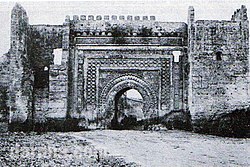Bab El Khemis, Meknes
| Bab El Khemis | |
|---|---|
|
UNESCO world heritage |
|

|
|
| Bab El Khemis gate construction |
|
| National territory: |
|
| Type: | Culture |
| Criteria : | (ii) (iv) |
| Reference No .: | 793 |
| UNESCO region : | Africa |
| History of enrollment | |
| Enrollment: | 1996 (session 20) |
The Bab El Khemis or just Bab Khemis ( Arabic باب الخميس, DMG Bāb al-Ḫamīs = "Thursday gate ") in the former Moroccan capital Meknes is one of the most important sights of the city and the whole country. Together with other historical buildings in Meknes, it has been a UNESCO World Heritage Site since 1996 .
location
The Bab El Khemis is located near the Jewish quarter ( mellah ) of the city, which has now almost disappeared . Today it is about 200 m from the bus station.
history
Bab El Khemis was in 1700 on behalf of the Alawites - Sultan Moulay Ismail (ruled 1672-1727.) - supposedly in gratitude for healing one of his daughters by a Jewish doctor - built. At the beginning of the 20th century it was in a ruinous state; however, it was extensively restored in the 1970s.
Architecture and building decor
The gate , made of rammed earth mixed with small stones (side bastions ) as well as bricks (middle part) is about 12 m high and closes with a crenellated wreath . The width of the outward-facing facade is approximately 10 m; the actual archway is approx. 5 m high and designed as a horseshoe arch - slightly sharpened at the apex . The upper part, framed by a rectangular frame ( alfiz ), shows jagged arches, but their artistic quality does not resemble the Almohad models in Marrakech ( Bab Agnaou ) and Rabat ( Bab des Oudaïas and Bab er Rouah ), which were built towards the end of the 12th century. reach out. The side gussets are adorned with blue ceramic tiles scratched into tendrils . This is followed by a wider frame with a potentially infinite Sebka pattern highlighted in green ; on the far outside there is another frame made of blue and white tile mosaic . The middle part closes with a band of inscriptions, the translation of which reads as follows: I keep the gate open for all peoples, whether in the west or east.
Others
In the city of Meknes there are other gateways from the time of Moulay Ismail; the largest and most important is the Bab Mansour , which is the very representative entrance to the former royal city (Ville Impériale) . Another is the Bab Berdayyin near the mosque of the same name .
literature
- Arnold Betten: Morocco. Antiquity, Berber Traditions and Islam - History, Art and Culture in the Maghreb. DuMont, Ostfildern 2012, pp. 64 and 166. ISBN 978-3-7701-3935-4
- Markus Hattstein, Peter Delius (Ed.): Islam. Art and architecture . Könemann Verlag, Cologne 2000, p. 305. ISBN 3-89508-846-3
Web links
- Bab El Khemis ArchNet (English)
Coordinates: 33 ° 53 ′ 28.5 ″ N , 5 ° 34 ′ 20 ″ W.

